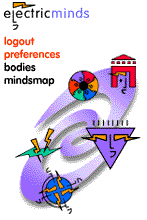
|

|


Electric Minds is proud to present excerpts from John Hagel III and Arthur G. Armstrong's Net Gain. In "Net Gain," Hagel and Armstrong outline their vision of the evolution of the on-line economy. They discuss how much companies need to spend, what they can expect to gain and when, and what skills will be required to organize and grow a virtual community. They claim that virtual communities represent an entirely new business model, and predict that over the next ten years, these on-line groups will be responsible for changing traditional industry structures and the organizations within them.  The rise of virtual communities in on-line networks has set in motion an unprecedented shift in power from vendors of goods and services to the customers who buy them. Vendors who understand this transfer of power and choose to capitalize on it by organizing virtual communities will be richly rewarded with both peerless customer loyalty and impressive economic returns. But the race to establish the virtual community belongs to the swift: those who move quickly and aggressively will gain -- and likely hold -- the advantage.
The rise of virtual communities in on-line networks has set in motion an unprecedented shift in power from vendors of goods and services to the customers who buy them. Vendors who understand this transfer of power and choose to capitalize on it by organizing virtual communities will be richly rewarded with both peerless customer loyalty and impressive economic returns. But the race to establish the virtual community belongs to the swift: those who move quickly and aggressively will gain -- and likely hold -- the advantage.
Commercial enterprises are relative newcomers to the on-line world, and so far few of them have made money there. Most businesses on the Internet and other networks today do little more than advertise their wares on "billboards" on the World Wide Web in the hope that a passing surfer will stop long enough to buy something. These old-media advertisements, dressed in their new-media clothes, are only one indication that marketers have yet to discover the secret to unlocking the revolutionary potential of the Internet and other networks. Such diverse vendors as flower distributors, booksellers, liquor companies, and manufacturers of durable goods have rushed to develop sites on the World Wide Web where visitors can obtain information about the company and its products and send electronic messages. Some of the more sophisticated commercial sites allow visitors to play games and order products electronically. But rarely do these sites encourage communication between visitors to the site. Like every communications network, the Internet is all about establishing and reinforcing connections between people. By giving customers the ability to interact with each other as well as with the company itself, businesses can build new and deeper relationships with customers. We believe that commercial success in the on-line arena will belong to those who organize virtual communities to meet multiple social and commercial needs. By creating strong virtual communities, businesses will be able to build membership audiences and use those audiences to bring in revenues in the form of advertising, transaction fees, and membership fees. Some readers may argue that the Internet is not yet ready to meet the needs of their particular industry or market. Others may believe that the commercial potential of electronic commerce is unproven. Such skepticism is understandable given that as yet few businesses have discovered how to generate traffic at a Web site, let alone how to do business with customers when they get there or how to gather the kind of information from those customers that will interest other advertisers and vendors in participating in the site. These skeptics might argue that it won't be worthwhile competing on electronic networks until the economic model is more proven. Understandable as their doubts may be, we suspect such skeptics have yet to understand fully or take into account the laws of increasing returns and the ways in which they're changing the rules of the game in manufacturing, service, and knowledge-based industries. As Microsoft proved most spectacularly, harnessing the power of increasing returns means "the more you sell, the more you sell." Of course, the converse is also true: increasing returns make it all the more likely, if you are on the losing end in a market, that you will fall farther behind. That's why preemptive strategies become so important in markets where increasing returns prevail; if you don't get there first, you may be too late. As the saying goes in Silicon Valley, "Speed is God, and time is the devil." Who Benefits From Virtual Communities and Why The benefits of the virtual community go to both customer and vendor. The benefits to customers flow from the very characteristics that define a virtual community. The benefits to vendors have to do with new opportunities to expand their markets. Power to the customer Five defining elements of the virtual community business model combine to deliver this powerful value proposition:
Profit to the vendor Customers aren't the only ones who stand to benefit from virtual communities. Vendors will find in the virtual community a powerful vehicle for expanding their markets;as long as they don't let competitors or an independent third party beat them to the punch by capturing the primary loyalty of their customers. Virtual communities help vendors expand their markets on two levels: through capabilities that are unique to the virtual community business model and through capabilities that are more broadly available in network-based environments. Elements specific to virtual communities that help vendors expand their markets include the following.
The Challenge of Change Bridging the profound gap between the way traditional businesses are run and the way virtual communities will be built and run represents the single greatest challenge for senior management of existing companies. Most will need to adopt a mental model very different from the one they have in place. They'll need to rethink their notions of where value can be created and how they can capture value. Coming to a new understanding of where value can be created will require perhaps the greatest cognitive leap for the organizer of the virtual community. This is because recognizing the new source of value creation means switching allegiance: those organizations most firmly aligned with their members, those that represent members' interests in dealing with vendors;not those which see their mission as helping vendors to sell more effectively to customers;will be in the best position to capture value. The business model thus shifts from one in which the organization "pushes" products or services on target customers toward one in which it acts as an agent for customers, representing and championing their interests as they seek improved access to resources. In this way, virtual communities create "reverse markets," where customers seek out vendors and deal with them on a much more level playing field in terms of information access. This shift in power has three key implications:
Join the discussion of "Net Gain" in the Wealth of Networks conference.
Reprinted by permission of Harvard Business School Press. Excerpt from Net Gain by John Hagel III and Arthur G. Armstrong. Copyright © 1997 by McKinsey & Company, Inc.; all rights reserved. |
clm said: What strikes me as important about WebTV is that it is a proof of concept for the notion that the "client-side" can itself be implemented using a client-server model and extremely inexpensive clients. Or, another way of saying it, WebTV exploits the three-tier model of distributed app deployment. Microsoft (and others) have been promoting this model for quite some time. Most Active Topics: Topic 30 The Global Brain Topic 29 The Information Revolution - Paradigm Shift or Paranoid Shaft? Topic 18 Knowledge Workers: Leading, Keeping | |||
|
About the authors John Hagel III is a principal at the Silicon Valley office of McKinsey & Company, Inc., and a leader of the firm's Interactive Multimedia Practice. His work is primarily with clients in electronics, telecommunications, and media industries, with a focus on strategic management and performance improvement. Arthur G. Armstrong is a manager at the New York office of McKinsey. His work has primarily been with clients in the telecommunications, media, and consumer goods industries, with a focus on organization and performance improvement.
As Microsoft proved most spectacularly, harnessing the power of increasing returns means "the more you sell, the more you sell." The benefits of the virtual community go to both customer and vendor. The benefits to customers flow from the very characteristics that define a virtual community. The benefits to vendors have to do with new opportunities to expand their markets. The virtual community organizer must focus on two imperatives to deliver the value proposition: aggregating members and aggregating resources relevant to members. These two imperatives in turn suggest a third: aggregating information profiles about members' use of the network and the transactions they carry out on the network. Bridging the profound gap between the way traditional businesses are run and the way virtual communities will be built and run represents the single greatest challenge for senior management of existing companies. Most will need to adopt a mental model very different from the one they have in place. They'll need to rethink their notions of where value can be created and how they can capture value. | ||||
Also in Wealth of Networks: Platform Wars III: Clone Wars Excerpts from "Net Gain" Platform Wars II: | ||||
|
|
|
electric minds |
virtual community center |
world wide jam |
edge tech |
tomorrow |
conversations
Any questions? We have answers.
©1996, 1997 electric minds, all rights reserved worldwide.
|


